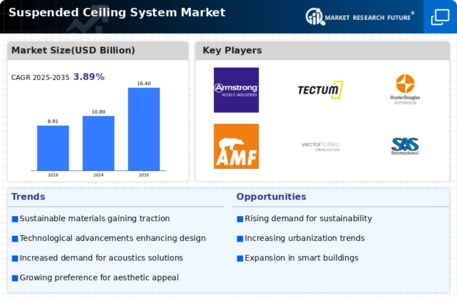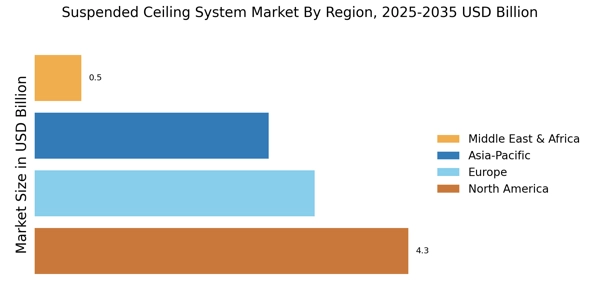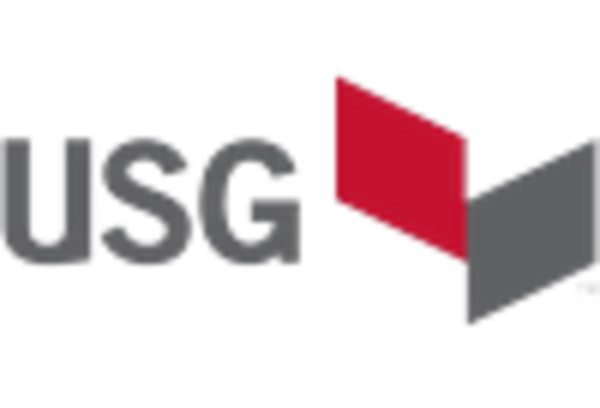The Suspended Ceiling System Market is currently characterized by a dynamic competitive landscape, driven by factors such as increasing demand for aesthetic and functional ceiling solutions in commercial and residential spaces. Key players like Armstrong World Industries (US), Saint-Gobain (FR), and USG Corporation (US) are at the forefront, each adopting distinct strategies to enhance their market positioning. Armstrong World Industries (US) emphasizes innovation in product design and sustainability, focusing on eco-friendly materials and energy-efficient solutions. Meanwhile, Saint-Gobain (FR) leverages its extensive The Suspended Ceiling System Market share through strategic acquisitions and partnerships, particularly in emerging markets. USG Corporation (US) appears to be concentrating on digital transformation, integrating advanced technologies into its manufacturing processes to improve efficiency and product quality. Collectively, these strategies contribute to a competitive environment that is increasingly focused on innovation and sustainability.
In terms of business tactics, companies are localizing manufacturing to reduce lead times and optimize supply chains, which is particularly crucial in a market that is moderately fragmented. This localization strategy not only enhances responsiveness to regional demands but also mitigates risks associated with global supply chain disruptions. The competitive structure of the market indicates that while a few players dominate, there remains ample opportunity for smaller firms to carve out niches, particularly through specialized products or services.
In August 2025, Armstrong World Industries (US) announced the launch of a new line of acoustic ceiling tiles designed specifically for high-performance environments, such as schools and hospitals. This strategic move underscores the company's commitment to addressing specific market needs while enhancing its product portfolio. By focusing on acoustic performance, Armstrong aims to differentiate itself in a crowded market, potentially capturing a larger share of the education and healthcare sectors.
In September 2025, Saint-Gobain (FR) completed the acquisition of a regional ceiling solutions provider in Southeast Asia, which is expected to bolster its presence in this rapidly growing market. This acquisition not only expands Saint-Gobain's product offerings but also enhances its distribution capabilities in a region where demand for suspended ceiling systems is on the rise. Such strategic acquisitions are indicative of the company's broader strategy to strengthen its competitive position through geographic expansion.
In October 2025, USG Corporation (US) unveiled a new digital platform aimed at streamlining the customer experience and improving order management. This initiative reflects a growing trend towards digitalization within the industry, as companies seek to leverage technology to enhance operational efficiency and customer engagement. By investing in digital solutions, USG positions itself as a forward-thinking leader in the market, likely appealing to tech-savvy customers and contractors.
As of October 2025, the competitive trends within the Suspended Ceiling System Market are increasingly shaped by digitalization, sustainability, and the integration of advanced technologies such as AI. Strategic alliances are becoming more prevalent, as companies recognize the value of collaboration in driving innovation and expanding market reach. Looking ahead, it appears that competitive differentiation will increasingly hinge on factors beyond price, with a pronounced shift towards innovation, technological advancement, and the reliability of supply chains. This evolution suggests that companies that prioritize these elements will likely emerge as leaders in the market.


















Leave a Comment